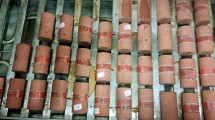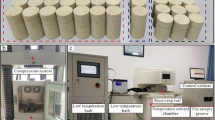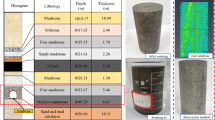Abstract
The fracture mechanics of frozen rock are important to engineering in cold regions, yet the basic properties and influences remain unclear. The fracture toughness of semi-circular bend (SCB) samples with different initial saturation degrees (ISDs) was tested at − 20 ℃. Acoustic emission (AE) and digital image correlation (DIC) systems were used to capture AE signals and surface deformation under load testing. In addition, the phase composition in rock pores was measured by low-field nuclear magnetic resonance (LF-NMR). It was found that: (1) Fracturing of frozen sandstone generally consists of three stages: pore or microcrack closing, elastic deformation and microcrack propagation which is evidenced by the variation of AE counts and the maximum horizontal strain within the fracture process zone (FPZ) under loading. (2) The ISD has a great influence on fracture toughness and the microcrack propagation process. With increases in ISD, both the fracture toughness and fracture energy of frozen sandstone varies in a mode of slow increase (ISD < 40%), rapid increase (ISD 40–90%) and slight decrease (ISD 90–100%). (3) The phase composition in pores of frozen rock with low ISD (< 40%) is significantly different from that with high ISD (40–100%). At ISDs of < 40%, the ice in rock pores mainly originates from adsorbed water; however, at ISDs of 40–100%, the ice increasingly comes from free and capillary water. Based on the test results, the difference in fracture mechanical properties of frozen sandstone introduced by different ISDs can be attributed to the changes in pore phase composition, which determines the interaction between pore ice/unfrozen water and rock skeleton involving three processes: strengthening due to the filling effect of pore ice, strengthening due to the adhesion force and tensile strength of pore ice, and weakening due to frost damage.
Highlights
-
Freezing strengthens water-bearing sandstone significantly, and the fracture toughness of frozen sandstone increases with its initial saturation degree.
-
Initial saturation degree differs the fracturing process of frozen sandstone in terms of energy release and range of fracture process zone.
-
Pore phase composition primarily determines the fracturing behaviour of frozen sandstone involving ice–pore interactions.
-
The ice–pore cementation and tensile strength of ice are the main contributors to the increase of fracture toughness of frozen rock.












Similar content being viewed by others
Abbreviations
- SCB:
-
Semi-circular bend
- ISD:
-
Initial saturation degree
- AE:
-
Acoustic emission
- DIC:
-
Digital image correlation
- LF-NMR:
-
Low-field nuclear magnetic resonance
- ROI:
-
Region of interest
- FPZ:
-
Fracture process zone
- FID:
-
Free induction decay
- KIC :
-
Mode-I fracture toughness
- a :
-
Length of the prefabricated crack
- R :
-
Radius of the SCB specimen
- B :
-
Thickness of the SCB specimen
- P max :
-
The peak load
- \(Y^{\prime}\) :
-
A non-dimensional stress intensity factor
- T 2 :
-
Transverse relaxation time of NMR signal
- T:
-
Temperature
- \(S_{w}\) :
-
The normalized unfrozen water content of frozen rock
- \(FID_{A}\) :
-
The FID value from the experimental measurement of the sample frozen at − 20 °C
- \(FID_{B}\) :
-
The FID value from the regression line at − 20 °C
- \(S_{t}\) :
-
The initial saturation degree at room temperature
- \(S_{i}\) :
-
The normalized ice content of a specimen.
- \(S_{a}\) :
-
The normalized content of ice which is frozen by adsorbed water
- \(S_{cb}\) :
-
The normalized content of ice that came from capillary and bulk water
- \(A_{{T_{2} , < 3}}^{unfrozen}\) :
-
The area of the T2 spectrum corresponding to the adsorbed water when the sample is unfrozen
- \(A_{{T_{2} , < 3}}^{frozen}\) :
-
The area of the T2 spectrum corresponding to the adsorbed water when the sample is frozen
- \(A_{{T_{2} }}^{unfrozen}\) :
-
The area of the T2 spectrum when the sample is unfrozen
- \(A_{{T_{2} }}^{frozen}\) :
-
The area of the T2 spectrum when the sample is frozen
- \(\alpha\) :
-
Stress–concentration factor
- a :
-
The microcrack length
- \(\rho\) :
-
The curvature radius at the end of a microcrack
- \(\sigma_{\max }\) :
-
The maximum stress at the end of a microcrack
- \(\sigma\) :
-
The average stress
References
Abdolghanizadeh K, Hosseini M, Saghafiyazdi M (2020) Effect of freezing temperature and number of freeze–thaw cycles on mode I and mode II fracture toughness of sandstone. Theoret Appl Fract Mech 105:102428. https://doi.org/10.1016/j.tafmec.2019.102428
Atkinsona J, Durhama WB, Seagera S (2018) The strength of ice-saturated extraterrestrial rock analogs. Icarus 315:61–68. https://doi.org/10.1016/j.icarus.2018.06.016
Ayatollahi MR, Akbardoost J (2012) Size effects on fracture toughness of quasi-brittle materials–a new approach. Eng Fract Mech 92:89–100
Bai Y, Shan RL, Ju Y, Wu YX, Sun PF, Wang ZE (2020) Study on the mechanical properties and damage constitutive model of frozen weakly cemented red sandstone. Cold Reg Sci Technol 171:102980. https://doi.org/10.1016/j.coldregions.2019.102980
Benson PM, Vinciguerra S, Meredith PG, Young RP (2010) Spatio-temporal evolution of volcano seismicity: a laboratory study. Earth Planet Sci Lett 297(1–2):315–323. https://doi.org/10.1016/j.epsl.2010.06.033
Blanchet D, Lenstra N, Skalski J, Zhou J, Smith B (2002) Pipeline trenching in permafrost: a review. Int Pipeline Conf 36207:229–238
Brooks Z, Ulm FJ, Einstein HH (2013) Environmental scanning electron microscopy (ESEM) and nanoindentation investigation of the crack tip process zone in marble. Acta Geotech 8(3):223–245. https://doi.org/10.1007/s11440-013-0213-z
Cao RH, Wang C, Yao R, Hu T, Lei D, Lin H, Zhao Y (2020) Effects of cyclic freeze-thaw treatments on the fracture characteristics of sandstone under different fracture modes: laboratory testing. Theoret Appl Fract Mech 109:102738. https://doi.org/10.1016/j.tafmec.2020.102738
Carr HY, Purcell EM (1954) Effects of diffusion on free precession in nuclear magnetic resonance experiments. Phys Rev 94:630–638. https://doi.org/10.1103/PhysRev.94.630
Chen HX, Wu YC, Xia HY, Jing BY, Zhang QJ (2018) Review of icepavement adhesion study and development of hydrophobic surface in pavement deicing. J Traffic Transport Eng (engl Ed) 5:224–238. https://doi.org/10.1016/j.jtte.2018.03.002
Coates GR, Galford J, Mardon D, Marschall D (1998) A new characterization of bulk-volume irreducible using magnetic resonance. Log Anal 39(1):51–63
Cowan BP (1997) Nuclear Magnetic Resonance and Relaxation. Cambridge University Press, Cambridge
Dastidar R (2007) Nuclear magnetic resonance (NMR) study of freezing and thawing of saturated porous media and application to shale and pore volume compressibility estimation Dissertation, University of Oklahoma, USA
Deng Z, Zhan X, Zeng W, Yang S, Wu J (2021) A degradation model of mode-I fracture toughness of rock under freeze-thaw cycles. Theoret Appl Fract Mech 115:103073. https://doi.org/10.1016/j.tafmec.2021.103073
Draebing D, Krautblatter M, Hoffmann T (2017) Thermo-cryogenic controls of fracture kinematics in permafrost rockwalls. Geophys Res Lett 44(8):3535–3544. https://doi.org/10.1002/2016GL072050
Dwivedi RD, Soni AK, Goel RK, Dube AK (2000) Fracture toughness of rocks under sub-zero temperature conditions. Int J Rock Mech Min Sci 37(8):1267–1275. https://doi.org/10.1016/S1365-1609(00)00051-4
Godefroy S, Korb JP, Fleury M, Bryant RG (2001) Surface nuclear magnetic relaxation and dynamics of water and oil in macroporous media. Phys Rev E 64:021605. https://doi.org/10.1103/PhysRevE.64.021605
Guerin F, Laforte C, Farinas MI, Perron J (2016) Analytical model based on experimental data of centrifuge ice adhesion tests with different substrates. Cold Reg Sci Technol 121:93–99. https://doi.org/10.1016/j.coldregions.2015.10.011
Guo ZK, Kobayashi A (1993) Further studies on fracture process zone for mode I concrete fracture. Eng Fract Mech 46(6):1041–1049. https://doi.org/10.1016/0013-7944(93)90155-L
Guo TY, Wong LNY (2020) Microcracking behavior of three granites under mode I loading: insights from acoustic emission. Eng Geol 278:105823. https://doi.org/10.1016/j.enggeo.2020.105823
Hansen-Goos H, Wettlaufer JS (2010) Theory of ice premelting in porous media. Phys Rev E 81(3):031604. https://doi.org/10.1103/PhysRevE.81.031604
He S, Feng Z, Rowlands RE (1997) Fracture process zone analysis of concrete using moiré interferometry. Exp Mech 37(3):367–373. https://doi.org/10.1007/BF02317433
Hillerborg A, Modéer M, Petersson PE (1976) Analysis of crack formation and crack growth in concrete by means of fracture mechanics and finite elements. Cem Concr Res 6(6):773–781. https://doi.org/10.1016/0008-8846(76)90007-7
ISRM (2007) The complete ISRM suggested methods for rock characterization, testing and monitoring: 1974–2006. In: Ulusay R, Hudson JA (eds) Suggested methods prepared by the commission on testing methods, International Society for Rock Mechanics, compilation arranged by the ISRM Turkish National Group. Kozan Ofset, Ankara
Jia HL, Ding S, Wang Y, Zi F, Sun Q, Yang GS (2019) An NMR-based investigation of pore water freezing process in sandstone. Cold Reg Sci Technol 168:102893. https://doi.org/10.1016/j.coldregions.2019.102893
Jia HL, Zi F, Yang GS, Li GQ, Shen YJ, Sun Q, Yang P (2020) Influence of pore water (ice) content on the strength and deformability of frozen argillaceous siltstone. Rock Mech Rock Eng 53:967–974. https://doi.org/10.1007/s00603-019-01943-0
Jia HL, Wang T, Chen WH, Ding S, Luo T, Sun Q (2021) Microscopic mechanisms of microwave irradiation thawing frozen soil and potential application in excavation of frozen ground. Cold Reg Sci Technol 184:103248. https://doi.org/10.1016/j.coldregions.2021.103248
Jiang R, Dai F, Liu Y, Li A, Feng P (2021) Frequency characteristics of acoustic emissions induced by crack propagation in rock tensile fracture. Rock Mech Rock Eng 54(4):2053–2065. https://doi.org/10.1007/s00603-020-02351-5
Johansen NI, Huang SL, Aughenbaugh NB (1988) Alaska’s CRREL permafrost tunnel. Tunn Undergr Space Technol 3(1):19–24. https://doi.org/10.1016/0886-7798(88)90030-2
Kodama J, Goto T, Fujii Y, Hagan P (2013) The effects of water content, temperature and loading rate on strength and failure process of frozen rocks. Int J Rock Mech Min Sci 62:1–13. https://doi.org/10.1016/j.ijrmms.2013.03.006
Kramarov V, Parrikar PN, Mokhtari M (2020) Evaluation of fracture toughness of sandstone and shale using digital image correlation. Rock Mech Rock Eng 53(9):4231–4250. https://doi.org/10.1007/s00603-020-02351-5
Kuruppu MD, Obara Y, Ayatollahi MR, Chong KP, Funatsu T (2014) ISRM-suggested method for determining the mode I static fracture toughness using semi-circular bend specimen. Rock Mech Rock Eng 47(1):267–274. https://doi.org/10.1007/s00603-013-0422-7
Lau CL (2016) Experimental investigation of the effect of water and temperature on mechanical properties of rocks. The University of Queensland, Bachelor of Engineering Thesis
Lin Q, Labuz JF (2013) Fracture of sandstone characterized by digital image correlation. Int J Rock Mech Min Sci 60:235–245. https://doi.org/10.1016/j.ijrmms.2012.12.043
Lin Q, Wang SQ, Pan PZ, Bian X, Lu YH (2020) Imaging opening-mode fracture in sandstone under three-point bending: a direct identification of the fracture process zone and traction-free crack based on cohesive zone model. Int J Rock Mech Min Sci 136:104516. https://doi.org/10.1016/j.ijrmms.2020.104516
Lindroth DP, Berglund WR, Wingquist CF (1995) Microwave thawing of frozen soils and gravels. J Cold Reg Eng 9(2):53–63. https://doi.org/10.1061/(ASCE)0887-381X(1995)9:2(53)
Lu P, Han J, Li Z, Xu R, Li R, Hao T, Qiao G (2020) Lake outburst accelerated permafrost degradation on Qinghai-Tibet Plateau. Remote Sens Environ 249:112011. https://doi.org/10.1016/j.rse.2020.112011
Martinez GA, Davis LA (2000) Petrophysical measurements on shales using NMR. In: SPE/AAPG Western Regional Meeting. https://doi.org/10.2118/62851-MS
Matteson A, Tomanic JP, Herron MM, Allen DF, Kenyon WE (1998) NMR relaxation of clay-brine mixtures. SPE Annu Tech Conf Exhib. https://doi.org/10.2118/49008-ms
Meiboom S, Gill D (1958) Modified spin-echo method for measuring nuclear relaxation times. Rev Sci Instrum 29:688–691. https://doi.org/10.1063/1.1716296
Mellor M (1971) Strength and deformation on rocks at low temperatures. CRREL Research Report 294. U.S. Army Cold Region Research and Engineering Laboratory, Hanover, New Hampshire
Muñoz-Ibáñez A, Delgado-Martín J, Juncosa-Rivera R (2021) Size effect and other effects on mode I fracture toughness using two testing methods. Int J Rock Mech Min Sci 143:104785. https://doi.org/10.1016/j.ijrmms.2021.104785
Pan B, Li K (2011) A fast digital image correlation method for deformation measurement. Optic Laser Eng 49(7):841–847. https://doi.org/10.1016/j.optlaseng.2011.02.023
Pan B, Xie H, Wang Z (2010) Equivalence of digital image correlation criteria for pattern matching. Appl Optic 49(28):5501–5509. https://doi.org/10.1364/AO.49.005501
Pan R, Zhang GQ, Li SY, Zheng XL, Xu CZ, Fan ZY (2021) Influence of the fracture process zone on fracture propagation mode in layered rocks. J Petrol Sci Eng 202:108524. https://doi.org/10.1016/j.petrol.2021.108524
Peng K, Lv H, Zou QL, Wen ZJ, Zhang YJ (2020) Evolutionary characteristics of mode-I fracture toughness and fracture energy in granite from different burial depths under high-temperature effect. Eng Fract Mech 239:107306. https://doi.org/10.1016/j.engfracmech.2020.107306
Petrovic JJ (2003) Review mechanical properties of ice and snow. J Mater Sci 38(1):1–6. https://doi.org/10.1023/A:1021134128038
Polovinko VA, Fedulov AI (1993) Abrasive wear of excavator teeth. J Min Sci 29(1):48–51
Rustan A, Vutukuri VS, Naarttijärvi T (1983) The influence from specific charge, geometric scale and physical properties of homogenous rock on fragmentation. Int Symp Rock Fragm Blast 1:115–142
Sammis C, Biegel R (2004) Mechanics of strengthening in crystalline rock at low temperatures: a preliminary assessment. In: Proceedings of the 26th seismic research review: trends in nuclear explosion monitoring, Orlando, Florida. LANL Press, pp 475–484
Singh RN, Sun G (1990) Application of fracture mechanics to some mining engineering problems. Min Sci Technol 10:53–60. https://doi.org/10.1016/0167-9031(90)90836-H
Skudrzyk FJ (1983) Preliminary studies of the effectiveness of water jet cutting on frozen ground: University of Alaska Mineral Industry Research Laboratory Open File 83–1, 34 p. http://hdl.handle.net/11122/2180
Teng J, Shan F, He Z, Zhang S, Zhao G, Sheng D (2019) Experimental study of ice accumulation in unsaturated clean sand. Géotechnique 69(3):251–259. https://doi.org/10.1680/jgeot.17.P.208
Teng J, Yan H, Liang S, Zhang S, Sheng D (2021) Generalising the Kozeny-Carman equation to frozen soils. J Hydrol 594:125885. https://doi.org/10.1016/j.jhydrol.2020.125885
Tice AR, Anderson DM, Sterrett KF (1982) Unfrozen water contents of submarine permafrost determined by nuclear magnetic resonance. Dev Geotech Eng 28:35–146. https://doi.org/10.1016/B978-0-444-42010-7.50017-7
Wang T, Sun Q, Jia HL, Ren JT, Luo T (2021) Linking the mechanical properties of frozen sandstone to phase composition of pore water measured by LF-NMR at subzero temperatures. Bull Eng Geol Environ 80:4501–4513. https://doi.org/10.1007/s10064-021-02224-3
Watanabe K, Wake T (2009) Measurement of unfrozen water content and relative permittivity of frozen unsaturated soil using NMR and TDR. Cold Reg Sci Technol 59(1):34–41. https://doi.org/10.1016/j.coldregions.2009.05.011
Wei MD, Dai F, Xu NW, Zhao T, Xia KW (2016) Experimental and numerical study on the fracture process zone and fracture toughness determination for ISRM-suggested semi-circular bend rock specimen. Eng Fract Mech 154:43–56. https://doi.org/10.1016/j.engfracmech.2016.01.002
Xie ZY, Sun J, Yao Q (2019) Experiment study on relationship between material composition and acoustic emission peak frequency. J Heilongjiang Univ Sci Technol 29(6):674–677
Zhang G, Xing Y, Wang L (2018) Comprehensive sandstone fracturing characterization: Integration of fiber Bragg grating, digital imaging correlation and acoustic emission measurements. Eng Geol 246:45–56. https://doi.org/10.1016/j.enggeo.2018.09.016
Zhang S, Wang H, Li X, Zhang X, An D, Yu B (2021) Experimental study on development characteristics and size effect of rock fracture process zone. Eng Fract Mech 241:107377. https://doi.org/10.1016/j.engfracmech.2020.107377
Zhao Y, Sun Y, Liu S, Wang K, Jiang Y (2017) Pore structure characterization of coal by NMR cryoporometry. Fuel 190:359–369. https://doi.org/10.1016/j.fuel.2016.10.121
Zhou ZL, Cai X, Ma D, Cao WZ, Chen L, Zhou J (2018) Effects of water content on fracture and mechanical behavior of sandstone with a low clay mineral content. Eng Fract Mech 193:47–65. https://doi.org/10.1016/j.engfracmech.2018.02.028
Acknowledgements
This work was supported by the National Natural Science Foundation of China (Grant No. 41702334, 42077274); Open foundation of State Key Laboratory of Frozen Soil Engineering (Grant No. SKLFSE201807).
Author information
Authors and Affiliations
Corresponding author
Ethics declarations
Conflict of interest
None.
Additional information
Publisher's Note
Springer Nature remains neutral with regard to jurisdictional claims in published maps and institutional affiliations.
Rights and permissions
About this article
Cite this article
Wang, T., Sun, Q., Jia, H. et al. Fracture Mechanical Properties of Frozen Sandstone at Different Initial Saturation Degrees. Rock Mech Rock Eng 55, 3235–3252 (2022). https://doi.org/10.1007/s00603-022-02830-x
Received:
Accepted:
Published:
Issue Date:
DOI: https://doi.org/10.1007/s00603-022-02830-x




